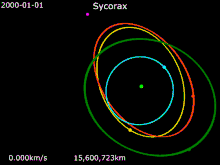Trinculo (moon)
Trinculo /ˈtrɪŋkjʊloʊ/ is a retrograde irregular satellite of Uranus. It was discovered by a group of astronomers led by Holman, et al. on 13 August 2001, and given the temporary designation S/2001 U 1.[1]
| Discovery | |
|---|---|
| Discovered by | |
| Discovery date | August 13, 2001[1][2] (confirmed in 2002[1][3]) |
| Designations | |
Designation | Uranus XXI |
| Pronunciation | /ˈtrɪŋkjʊloʊ/[4][5] |
| Adjectives | |
| Orbital characteristics | |
Mean orbit radius | 8,504,000 km[6][7] |
| Eccentricity | 0.2200[6][7] |
| 749.24 d | |
| Inclination | 167° (to the ecliptic)[6] |
| Satellite of | Uranus |
| Physical characteristics | |
Mean radius | 9 km (estimate)[8] |
| ~1,000 km2 (estimate) | |
| Volume | ~3,000 km3 (estimate) |
| Mass | ~3.9×1015 kg (estimate) |
Mean density | ~1.3 g/cm3 (assumed) |
| ~0.0021 m/s2 (estimate) | |
| ~0.007 km/s (estimate) | |
| ? | |
| ? | |
| Albedo | 0.04 (assumed)[8] |
| Temperature | ~65 K (estimate) |
Confirmed as Uranus XXI, it was named after the drunken jester Trinculo in William Shakespeare's play The Tempest. Trinculo is the smallest of Uranus' 27 moons and is approximately only 18 km wide and is roughly the size of Manhattan Island.

Animation of Sycorax's orbit around Uranus.
Uranus · Sycorax · Francisco · Uranus · Caliban · Stephano · Trinculo
Uranus · Sycorax · Francisco · Uranus · Caliban · Stephano · Trinculo
See also
- Uranus' natural satellites
References
- Daniel W. E. Green (2002-09-30). "IAUC 7980: S/2001 U 1". IAU Circular. Retrieved 2011-01-08.
- Jennifer Blue (2008-10-16). "Planet and Satellite Names and Discoverers". Working Group for Planetary System Nomenclature (WGPSN). Retrieved 2008-12-19.
- Sheppard, Scott S. "New Satellites of Uranus Discovered in 2003". Institute for Astronomy at the University of Hawaii. Archived from the original on 5 May 2008. Retrieved 2008-12-19.
- Shakespeare Recording Society (1995) The Tempest (audio CD)
- Benjamin Smith (1903) The Century Dictionary and Cyclopedia
- Sheppard, Jewitt & Kleyna 2005, p. 523, Table 3.
- Jacobson, R.A. (2003) URA067 (2007-06-28). "Planetary Satellite Mean Orbital Parameters". JPL/NASA. Retrieved 2008-01-23.
- Sheppard, Jewitt & Kleyna 2005, p. 523, Table 3 ... ri (km) ... 9 ... i Radius of satellite assuming a geometric albedo of 0.04.
- Sheppard, S. S.; Jewitt, D.; Kleyna, J. (2005). "An Ultradeep Survey for Irregular Satellites of Uranus: Limits to Completeness". The Astronomical Journal. 129: 518. arXiv:astro-ph/0410059. Bibcode:2005AJ....129..518S. doi:10.1086/426329.
External links
This article is issued from Wikipedia. The text is licensed under Creative Commons - Attribution - Sharealike. Additional terms may apply for the media files.

